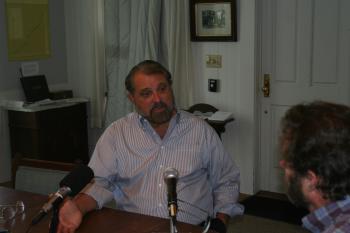Robert Schmieder

Cordell Expeditions
This is a compilation of oral history interviews with core team members of Cordell Expeditions, the team of divers that pioneered exploration of Cordell Bank in the late 1970s and 1980s. These individuals' efforts were instrumental in the discovery of Cordell Bank's biological richness, its nomination and designation as a National Marine Sanctuary. The extraordinary biodiversity of this special place was recognized in 1989, when Congress designated Cordell Bank National Marine Sanctuary. Today sanctuary staff work to protect the Cordell Bank region through research, regulations, and education. Interviews were conducted with Cordell Expeditions 'core team' members (those that were significantly involved in the expedition from the beginning to end).
Robert William Schmieder, born on July 10, 1941, in Phoenix, Arizona, is a distinguished American scientist and explorer whose remarkable career spans a wide array of scientific disciplines. He has made significant contributions to both the physical sciences and natural science exploration. He obtained a B.A. in Physics from Occidental College, a B.S. in Physics from the California Institute of Technology, an M.A. in Physics, and a Ph.D. in Physics from Columbia University. His early research pursuits encompassed atomic and nuclear physics, with pioneering work in hyperfine structure constants and lifetimes of free alkali atoms. Later, during his tenure at Sandia National Laboratories, he invented laser spark spectroscopy, a technique that has since been commercialized. Schmieder's scientific explorations extended beyond the laboratory, as he embarked on a series of groundbreaking expeditions to remote oceanic locations during the mid-1970s. His efforts culminated in numerous discoveries within the fields of geography, geology, and marine biology, ultimately leading to the establishment of the Cordell Bank National Marine Sanctuary. He also unveiled the mysteries of Schmieder Bank, a previously unknown underwater bank off the coast of Monterey, and led investigations into various other uncharted territories, amassing an extensive body of scientific observations and findings.
Scope and Content Note
Session 1: This interview with Dr. Robert Schmieder covers various aspects of his involvement in the exploration of Cordell Bank, spanning from its conception to the third season in 1980. Dr. Schmieder's background, education, and early interest in exploration are discussed, leading to his decision to delve into marine exploration. He provides insights into the meticulous planning, safety measures, and team formation for the Cordell Bank expedition, emphasizing the challenges and dedication involved. The early stages of planning and preparation are detailed, including the design of collecting apparatuses, experimentation with underwater communication devices, and the eventual adoption of basic diver's equipment. Robert talks about challenges in interpreting nautical charts, navigating rough seas, and forming a suitable team. He reflects on the importance of team dynamics and his account of the first successful dive on Cordell Bank highlight the project's determination and initial accomplishments. A significant portion of the interview focuses on Dr. Schmieder's personal experience during dives at Cordell Bank. He describes the anticipation, underwater environment changes, and encounters with marine life. Challenges in descent line placement and safety measures are discussed, along with the team's efforts to preserve collected specimens. Robert mentions funding sources, including self-funding, grants from National Geographic and the Explorers Club, and support from NOAA's Sanctuary Programs Division.
Session 2: This interview explores Schmieder's experiences, observations, and contributions to the understanding and establishment of Cordell Bank National Marine Sanctuary. Schmieder, founder of Cordell Expeditions, provides insights into Cordell Bank's unique underwater ecosystem, its species composition, ecological dynamics, and the intriguing discovery of man-made holes on the underwater island. He discusses his involvement in underwater exploration, the formation of Cordell Expeditions, and his role in advancing research and documentation. He highlights the challenges and successes of obtaining research vessels, collecting and identifying specimens, engaging with specialists, and contributing to the establishment of the sanctuary. The interview also addresses Schmieder's perspective on the sanctuary's significance, the transition of his involvement, and his concerns for its future in the face of political and economic factors.
Please Note: The oral histories in this collection are protected by copyright and have been created for educational, research and personal use as described by the Fair Use Doctrine in the U.S. Copyright law. Please reach out Voices@noaa.gov to let us know how these interviews are being used in your research, project, exhibit, etc. The Voices staff can help provide other useful resources related to your inquiry.
The NOAA mission is to understand and predict changes in climate, weather, oceans, and coasts, to share that knowledge and information with others, and to conserve and manage coastal and marine ecosystems and resources. The Voices Oral History Archives offers public access to a wide range of accounts, including historical materials that are products of their particular times, and may contain offensive language or negative stereotypes.
Voices Oral History Archives does not verify the accuracy of materials submitted to us. The opinions expressed in the interviews are those of the interviewee only. The interviews here have been made available to the public only after the interviewer has confirmed that they have obtained consent.
